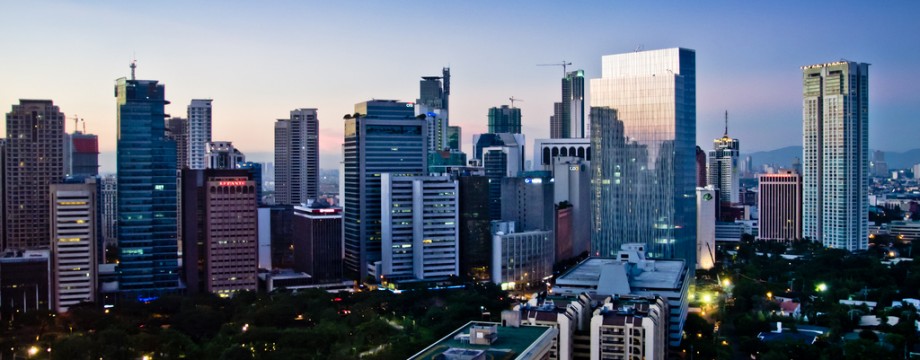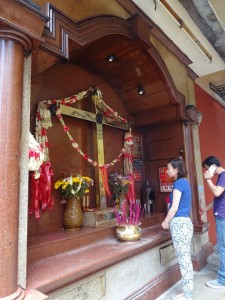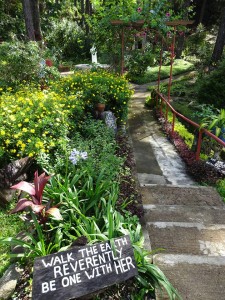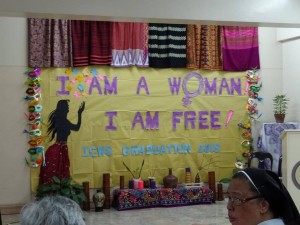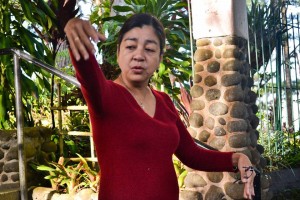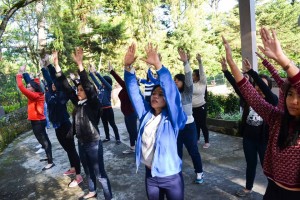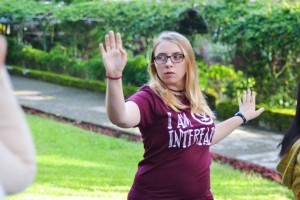At Illinois Wesleyan I’m a Multifaith Ambassador employed through Evelyn Chapel (I help to plan interfaith programming for our campus and to engage with the various religious and nonreligious groups at IWU to build an appreciation for the religious diversity on our campus and in our world), so I’ve been especially sensitive and interested in the religious elements of this culture I’ve found myself in here in the Philippines. Of course, I’ve been doing my internship in an explicitly Catholic school, but the culture of this country has in itself been a Catholic Immersion experience for me. I’ll be sharing a little bit about what I’ve learned about Filipino Catholicism and religion, as well as sharing some of my personal connections to the Catholicism here.
[But first, for those who are not familiar with the term, here’s the pitch:]
The Interfaith movement tries to establish bonds between people of different faiths (and non-faiths) by allowing them to see places of commonality and shared values. Although it does not say that all religions are the same and of equal standing (there is room for respectful criticism), and it also seeks to tactfully explore places of profound difference between people of different faiths, trying to create narratives of shared understanding is a major step towards building relationships between people with different beliefs. In our world where religion is so often used to build walls between people, scapegoat groups as “the Other” and then justify violence and discrimination against a group of people based on misconceptions and rumors about what they belief, personal experience with a foreign faith tradition and exploring places of commonality between your beliefs and theirs is vitally important.
I don’t know much about mainstream Catholicism for which to compare to how the Filipinos practice their faith, but I believe their Crucifixions during Holy Week are specific to the Philippines. Yes – some devotees will nail themselves to a cross and torture themselves to show their devotion, and it’s actually a popular pilgrimage site as a spectator event. I suppose it’s not the only religious expression of devotion that an outsider might observe as torture. Among the Lakota, Crow, and other Plains tribes, for example, young men will pierce their chests and backs during the Sun Dance, and attach themselves to a center post or to a chain of buffalo skulls with sinew or leather and dance until the skin tears free from the weight.
There are different holy icons and images of Jesus and Mary here and well, such as the Santo Nino (Christ as a child), The Sacred Heart of Jesus, the Black Nazarene (Crucifixion Jesus bearing the weight of the Cross), Mother of All, Queen of Virgins, etc. We were told that the images of Santo Nino and the Black Nazarene are especially popular here because Filipinos, culturally, possess both a childlike exuberance and have a narrative of suffering and oppression, so both of these images are ones they can identify with. In fact, there’s a pilgrimage to the Black Nazarene at a Church in Quiapo (within Metro Manila) each January. It’s believed that if you have an ailment and you wipe a cloth from the statue to your sickness, you’ll be cured. Ironically, this festival is so popular that some die in the stampede to get to the healing statue.
Although Islam predates Catholicism in the Philippines by 300 years, Islam and Protestantism are not the only salient minority faiths here. Among them is Iglesia ni Christo – the “Church of Christ.” I had never heard of it before coming here, but I see it’s churches (uniform in their design) everywhere. It is a Christian religion that originated in the Philippines as an offshoot of Catholicism, but places less emphasis on the Virgin Mary and includes some other interesting elements. The Wikipedia page for Iglesia ni Christo states:
“The Iglesia ni Cristo proclaims itself to be the one true church and says that it is the restoration of the original church founded by Jesus and that all other Christian churches, including the Roman Catholic Church and Protestant sects, are apostates. INC doctrine cites that the official registration of the Church with the Government of the Philippine Islands on July 27, 1914, by Felix Manalo—upheld by its members to be the last messenger of God—was an act of divine providence and the fulfillment of biblical prophecy concerning the reestablishment of the Church of Christ in the Far East concurrent with the coming of the Seventh seal marking the end of days.”
Most mainstream Catholics here see Iglesia ni Christo as a kind of cult, and we were told that in political elections all the followers vote how their leader votes (so politicians often try to win over the leaders.) We were also told that during disasters, such as during Typhoon Yolanda two years ago, only members of Iglesia ni Christo were allowed to seek shelter in the church, which was on high ground. The rest of the population was excluded and denied help.
I’ve also seen some interesting religious fusion in Binondo, the world’s oldest Chinatown.
The Catholicism here is something I’ve wondered at, actually: the atmosphere of lingering resentment over the historical exploitation from foreign powers leaves me questioning the strong convictions and faith in this country. I have often wondered about the deeply-held Christian faith of African-Americans in the United States as well, because I know that the history of their religion in relation to their culture is also one of compulsion, just as it was in relation to our indigenous Native American peoples in the States. The Native American history of compulsory conversion to the Christian faith and of banning the practice of their native religion, however, has in the modern day birthed a strong movement to return to the faith of their ancestors and regain some of the culture that was taken from them. I suppose though, I can connect this to the revival of Wicca and Neopaganism today. There have been some criticisms that the historical narrative of ancient Goddess traditions are based more on myth an scholarship, and in her seminal work “The Spiral Dance,” author Starhawk writes:
“The idea seems to be that if they can disprove our origin story, they can invalidate our spirituality […] In reality, […] the truth of our experience is valid whether it has roots thousands of years old or thirty minutes old. […] What gives [our tradition] validity is how it works for us now, in the moment, not whether or not someone has worshipped this particular image in the past.”
Perhaps in the same way, modern Catholicism for Filipinos is an expression of their current culture as the culmination of their history and national experience. And that douesn’t discount the validity or genuine nature of their faith.
In my time here, I’ve been able to experience quite a few things that are very much in line with my own beliefs amidst a very Catholic environment, and with other Catholics! While I’m still trying to come up with a good term to describe what I believe, the best I’ve been able to manage so far is “Neo-pagan Humanist.” I identify a lot with the teachings of Wicca, which is a nature-based religion and a revival of pre-Christian Celtic traditions (hence the “Neo-pagan”). I have also had quite a bit of influence from Native American, especially Lakota, religious beliefs, as my father used to live and teach on Pine Ridge Reservation in South Dakota and I was raised with some of the impact it had made on him. However, the awareness of my own white skin and my unwillingness to be appropriative of a culture that I cannot lay claim to makes me more comfortable with Celtic shamanism and beliefs than with Lakota ritual. What it comes down to is the reverence I give to the Earth/nature and to the Goddess-concept as sacred things, and these are what I’ve been able to connect to during my time here.
One of the first things we experienced here was a send-off/graduation ritual of a Women’s training at Nursia Institute of Women’s Studies, where we’re staying. I was shocked to see a dance given by the graduates to the tune of “We All Come from the Goddess” – a song I discovered in Pagan circles. Yet there were nuns among those dancing, and another Sister singing along in the audience! Nursia actually has a lot of Goddess imagery as décor. St. Scho has surprised me like that – not only does this very Catholic school have such an emphasis on Women’s empowerment using the Goddess metaphor, but the value it places on nature and Mother Earth is also very spiritual in nature and something I can connect with. When we stayed at the St.Scholastica’s Convent in Baguio in June, there were many beautiful gardens that had signs talking about the sacredness of the Earth and the reverence we should have for Her. Our group even did Shibashi together – a Japanese form of meditation that focuses on being one with nature. I absolutely loved it, and I asked for a copy of the tape of Sister Mary John leading the meditation. 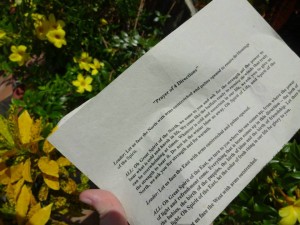 Of course, I’ve gotten to get one-on-one with nature here through the rice planting and tree planting trips. Getting into the dirt and mud is always somewhat of a spiritual experience for me, but that was heightened by me getting to lead a prayer in Tanauan before our tree planting. It was a “Four Directions Prayer,” modeled off of Native American traditions, with appeals to the Spirits of the Four Directions. This is something I’m familiar with from Lakota and Wiccan ritual, so I was more than happy leading the prayer.
Of course, I’ve gotten to get one-on-one with nature here through the rice planting and tree planting trips. Getting into the dirt and mud is always somewhat of a spiritual experience for me, but that was heightened by me getting to lead a prayer in Tanauan before our tree planting. It was a “Four Directions Prayer,” modeled off of Native American traditions, with appeals to the Spirits of the Four Directions. This is something I’m familiar with from Lakota and Wiccan ritual, so I was more than happy leading the prayer.
I’ve gotten to know a lot about Benedictine values by being at St. Scholastica’s these past two months, especially about service, stewardship, and student leadership. (I was even given a beautiful Benedictine Medal! Supposedly wearing it is supposed to keep you safe. Maybe St. Benedict only does so if you pray to him, but I know the prayers by heart now after hearing them so often, so maybe that counts.) St. Scholastica’s motto is “Ora et Labora,” which means “Prayer and Work.” Although this has an explicitly Christian connotation, I was actually able to connect it to a concept found in Wicca, called “acting in accord.” This relates to the practice of magick (spelled with a “k” to distinguish it from the concept of pulling rabbits out of hats), which is about raising focused energy towards a goal or intent. It’s like a very active form of prayer, wherein one decides to ask for something or express gratitude towards something, expresses that focus in a tangible way (like scattering coins on an altar or lighting green and gold candles if your desire is to attract some much-needed money into your life), and then raising energy (through dance, drumming, or song) to be released out into the universe with that focus attached to it. (Even if you don’t buy into the metaphysical laws believed to be in place here, it’s nonetheless an effective means to articulate what it is you want and then allows you to put work into acknowledging your goal, which keeps you thinking about it and looking for opportunities or ready to act). The “acting in accord” concept comes into play by saying that it is not enough to do a ritual to send off this energy and then hope it’ll work to your advantage – you then have to follow it up with actions that will allow opportunity to enter your life. (like going out and networking/sending out resumes if you want to get a job offer instead of staying home in your PJs to watch reruns of FRIENDS). It’s the “buying the ticket” part of hoping to win the lottery, and that’s how I personally connect to the phrase “Ora et Labora.”
Of course, there have been some places of interreligious friction when our values are not shared, as is to be expected. For instance, I do not put the same emphasis on obedience as something to be aspired to as some people here do, and my views on abortion and divorce in cases where the health, safety, and wellbeing of the mother or wife (or husband!) are threatened are different from some of the people I’ve spoken to here who believe that under no circumstances can a life brought into existence by God or two people having become one under the eyes of the Lord can be destroyed. But I’ve found ways to maintain my respect and friendships despite these differences. It has given me an appreciation of how secular our country truly is, though. With Christian convictions being a prerequisite to win enough of the popular vote to get into office and “Under God” being retained in our Pledge of Allegiance, I sometimes complain that our country is not as secular as it should be by claiming “separation of Church and State.” But here in the Philippines, Catholicism is as much a part of their culture as are dishes made with fish and served with rice – religious phrases are inscribed on the sides of jeepneys and pedicabs and rosaries hang from the rearview mirror in registered taxis (dangling behind the icons of saints, the Virgin Mary, and Jesus which are affixed to the dashboard). I hear the noon prayer every day at St. Scholastica’s College, naturally, but the noon prayer is also played over the PA system in shopping malls! Even though I knew from the start I’d be interning at a Benedictine affiliated college, I have been blown away by just how Catholic the school is. There is not an intra-office form that can be submitted or a presentation given (no matter how mundane or practical the topic) without referencing God and living in a Christ-centered way. St. Scholastica’s College truly lives out one of their favorite phrases: “That in all things, God may be glorified.” At times that has created a conflict for me: how “Catholic” do I present myself here? I don’t want to appear hypocritical or disrespect my own beliefs by portraying Christian amongst people who actually hold those Catholic convictions, but I know it’s what’s expected. Do I assimilate to the culture or preserve my own?
It has certainly been an immersion I’ve gotten a lot out of, and I can’t wait to come back to campus and share all I’ve learned here.

